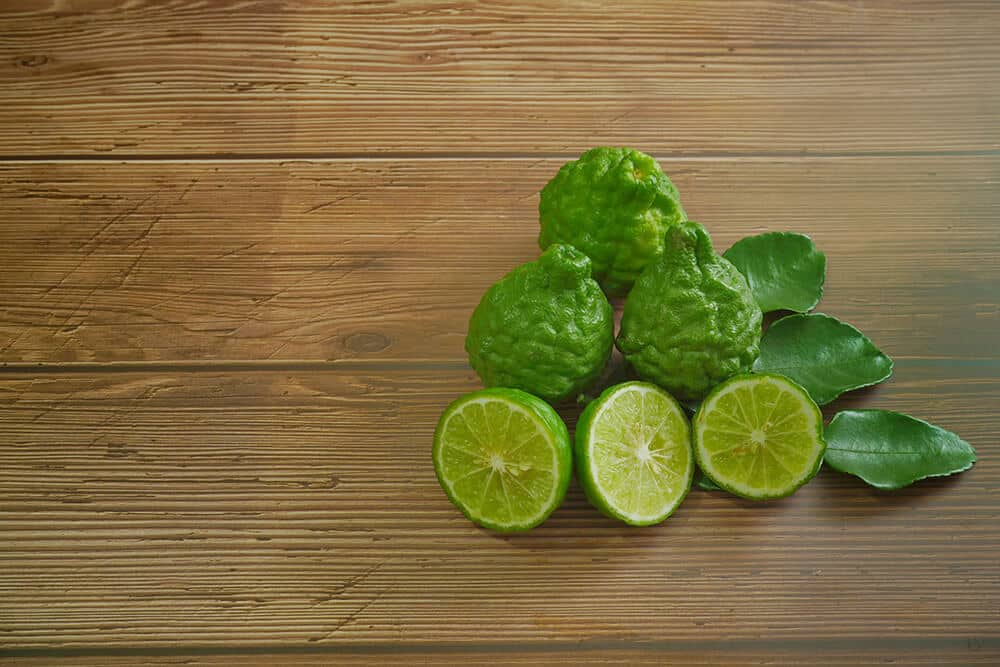Learn About Kaffir Lime And How It’s Used In Thai Curry
Table of Contents

How Kaffir Lime Is Used In Thai Curry Paste
The luscious and bright citrusy fragrance and taste of kaffir lime is why it is a superstar ingredient in Thai curry paste. Kaffir lime, also known as makrut lime, is a citrus fruit native to Indonesia.
The leaves, in particular, are often pounded into a paste together with other aromatic ingredients like garlic, shallots, lemongrass, and galangal. This combination creates a vibrant, aromatic base that sets Thai curries apart and makes them so incredibly delicious.
Kaffir lime is typically used as an ingredient in green and red curry paste as well as panang curry paste.
Which Parts Of Kaffir Lime Are Used In Cooking?
The culinary twinkle of kaffir lime is not limited to just one part of the fruit; both the leaves and the zest are used in cooking. This is one reason why it’s so popular to grow at home – its yield reaches far and wide.
Kaffir lime leaves are usually used either whole or finely shredded. They add a serious burst of citrusy taste to Thai soups, curries, stir-fries, and marinades. It is the fruit’s delicious flavor and light acidity that helps balance curries and sauces.
The zest, meanwhile, adds a sharp, tangy taste to various dishes. It enhances everything from marinades to desserts. Even the juice, though less common, adds a sour punch to sauces and dressings.
Kaffir Lime Substitutions: What are the Options?
What if the recipe calls for kaffir lime, but you can’t find it in stores? This shouldn’t be a huge problem, as there are a few substitutes that can mimic its unique taste. The most common substitute is a combination of regular lime leaves and lime zest.
You can also use lemon leaves or lemongrass for a similar aromatic quality. For the zest, try using lime or lemon zest as an alternative.
You can also find out more about how lemongrass is used in Thai cooking in the linked article.
While these substitutes may not perfectly replicate the distinct taste of kaffir lime, they can still provide a bright, citrusy flavor to your dishes.
Kaffir Lime Vs Lime: What’s The Difference?
Though they might seem similar at first glance, kaffir lime and regular lime have distinct differences.
Kaffir limes are smaller, with bumpy, wrinkled skin, and their flavor is more intense and fragrant.
Regular limes, on the other hand, are smooth and have a more straightforward and acidic taste.
The leaves of kaffir lime are also a key differentiator; they have a double-lobed shape and a unique smell that is far more potent than regular lime leaves.
These differences make kaffir lime a unique and irreplaceable ingredient in many Southeast Asian dishes.
Thai Dishes that include Kaffir Lime
Kaffir lime is a staple in many beloved Thai dishes. Besides many Thai curries, it is a key ingredient in Tom Yum soup, deepening the broth with its distinctive citrusy flavor.
Other popular dishes featuring kaffir lime include Thai fish cakes, where the leaves are finely chopped and mixed into the fish paste, and Thai salads, where they add a buzzing zing.
Each dish showcases the unique flavor profile of kaffir lime, making it a beloved ingredient in Thai cuisine.
Uses for Kaffir Lime Outside the Kitchen
Kaffir lime is not just a popular ingredient in the kitchen; it has a bunch of different uses outside of culinary use as well.
In traditional medicine, kaffir lime is often used for its antibacterial and anti-inflammatory properties.
The essential oil extracted from the fruit is popular in aromatherapy, known for its uplifting and invigorating scent. Kaffir lime is also used in natural cleaning products due to its powerful citrus oils, which are effective against bacteria and grime.
Additionally, its leaves are used in herbal teas and beauty treatments, proving that this humble fruit is as versatile as it is flavorful.
Kaffir lime is not just a culinary delight; it has various uses outside the kitchen as well. Here is a summary of how to use kaffir lime, other than in cooking:
- Traditional medicine: Used for its antibacterial and anti-inflammatory properties.
- Aromatherapy: The essential oil extracted from the fruit is known for its uplifting and invigorating scent.
- Hair treatment: The juice and leaves are often used in hair treatments to promote a healthy scalp and shiny hair.
- Natural cleaning products: Powerful citrus oils make it effective against bacteria and grime.
- Herbal teas: Kaffir lime leaves add a refreshing and health-boosting element to teas.
- Beauty treatments: Used in skincare products for its refreshing and rejuvenating properties.

About Nittaya Thai Curry
We believe that after reading this guide to kaffir lime as an ingredient in Thai cuisine, you may be eager to further explore the rich and diverse flavors of Thai cooking. Don’t forget that Nittaya Thai Curry paste is meticulously crafted to be ready-to-use, simplifying the process of creating an authentic and delicious Thai curry. This is why so many Thai restaurants and chefs trust and rely on our range of curry paste.



